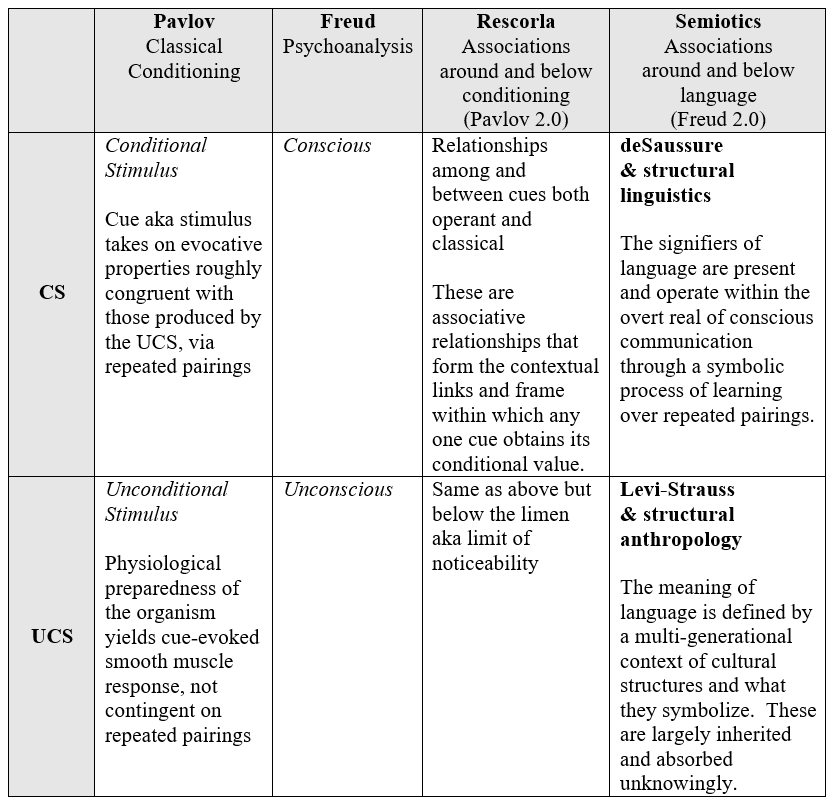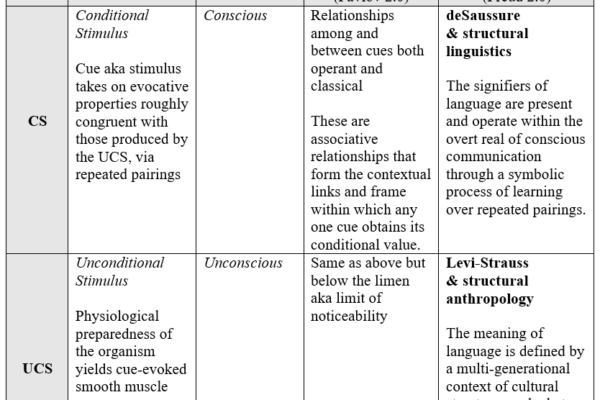A few weeks ago, while I was reading in the psychoanalytic literature, I saw that Freud (1915) abbreviates the Conscious mind with the initials “CS” and the Unconscious mind with the initials “UCS”. To me this seemed like much too much of a coincidence.
Why did it seem like a coincidence? From my rather extensive background in behaviorism, I know all too well that in the classical conditioning literature CS means “conditional stimulus” and UCS means “unconditional stimulus”.
Many undergraduate students are familiar with Pavlov’s preparation involving presentation of meat to a dog, the dog salivating, and then repeated pairing of a bell just before presentation of the meat over a series of days. The bell eventually evokes salivation without the presence of the meat. In that arrangement, the unconditional stimulus (UCS) is the meat and the conditional stimulus (CS) is the bell. After repeated parings a conditional response of salivation to the bell is developed, and that response is nearly identical to the unconditional response of salivation to the meat. That is to say, after repeated parings the bell comes to evoke salivation and previously the bell was neutral concerning salivation.
Classical conditioning (ala Pavlov) and operant conditioning (based on rewards and punishers ala Skinner) are often derided as an intellectually dead-end area of psychology. But they are much more than most people know them to be. And when our internal book club this year (2022) initially focused on Semiotics (and later in the year focused on Jacques Lacan) I was struck by a very significant parallel I realized between Semiotics and a special area within conditioning theories.
The parallel I noticed had to do with work in conditioning by Robert Rescorla. His work was central to my master’s thesis and related research Eric Corty and I published in 1995. In short, Rescorla highlighted the elaborate cue context within which Pavlov’s simple conditioning paradigm sits. Rescorla emphasized the meaning between and among the numerous cues collectively (time of day, various physical signals such as positional balance, and the full array of overt environmental cues) that are always present in any context. He added these considerations to the much more narrow arrangement Pavlov studied. Rescorla showed that there is an elaborate interplay among all contextual cues, and the conditional response varies as it depends upon the interplay of these cues and signal differences of meaning for the organism. Under conditions x, y, and z, the CS might take on a very different meaning than it would under very different conditions a, b, and c. Thus, Pavlov’s dog seems to salivate or not depending on internal representations of the meaning of the cues, rather than simply transferring a conditional reflex from a cue the animal is born to appreciate to a single neutral one.
Early this year we studied Ferdinand deSaussure and his work on structural linguistics. In short his work included how a cue can take on representational meaning: a sound may be a word in a language or a shape may be a sign with culturally bound significance. For deSaussure the signifier (e.g. a red light) and the signified (e.g. “Stop!”) are connected arbitrarily and with culturally bound meaning. For deSaussure any one word is studied in its current context within the language system, and not for its etymological history. Later in the year we learned how Claude Levi-Strauss applied deSaussure’s structural linguistics to the study of anthropology. He argued that an archeological artifact is a sign within a temporally bound culture system and must be understood within the cultural context of its place and time. Freud’s work on the content and operation of the human mind can be held as contextualized and amplified by these two theorists.
After a few weeks of further reading per our normal schedule, and my continued meditation on the exact parallel between Semiotics and Rescorla, I formed the following grid.
Overall, I see congruence in Pavlov and Freud dealing with both the overt (signifier) and the covert (signified) as drivers of what is – via association. And I see congruence in both Rescorla and Semiotics dealing with advancing their respective models via a multiplicity of cues (the surrounding content and context) and the relationships those form on horizontal and vertical axes. As you can see from the grid below, Rescorla is to Pavlov as Semiotics is to Freud.

